It is the software system that permits the management of the distributed database and makes the distribution transparent to users. A Distributed Database Management System (DDBMS) consists of a single logical database that is split into a number of fragments. Each fragment is stored on one or more computers under the control of a separate DBMS, with the computers connected by a communications network. Each site is capable of independently processing user requests that require access to local data and is also capable of processing data stored on other computers in the network. Users access the distributed database via applications. Applications are classified as those that do not require data from other sites (local Applications) and those that do require data from other sites (global applications). We require a DDBMS to have at least one global application.
Database Management Systems has quickly become one of the leading texts for database courses, known for its practical emphasis and comprehensive coverage. The third edition features new material on database application development, with a focus on Internet applications. The hands-on approach introduces students to current standards, including JDBC, XML, and 3-tier application architectures. A new, flexible organization allows instructors to teach either an applications-oriented course or an introductory systems-oriented course. The revised “part” organization with (new) Overview chapters makes it easy to select the chapters you need; in-depth chapters within each part can be optional.
This very current new edition also features pedagogical improvements (e.g., chapter objectives, review questions), and updated and extended discussions of data mining, database tuning wizards, decision support, information retrieval, Internet security, object-oriented databases, transaction processing, and XML data management. Throughout, the coverage has been revised and expanded to reflect the new SQL:1999 standard, including extensions that support multimedia data, object-relational databases, OLAP, recursive queries, spatial data, and SQL-J. The flexible organization and up-to-date discussion of advanced topics also makes the book ideal for use in a two-course sequence





0 comments:
Post a Comment